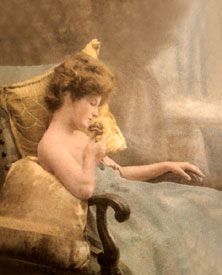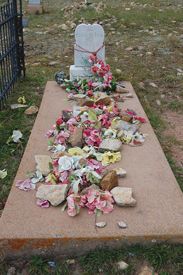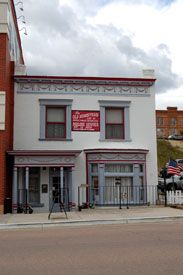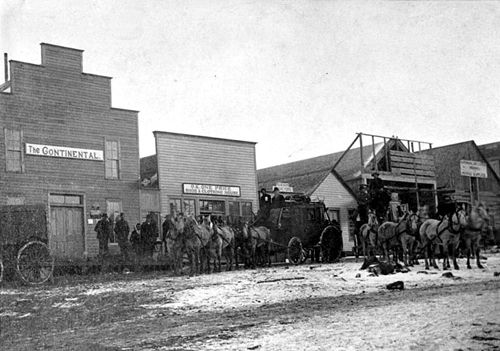
Cripple Creek, Colorado, 1890.
Pearl de Vere arrived in Cripple Creek, Colorado, from Denver during the Silver Panic of 1893. When the country moved to the gold standard, millionaires, including Horace Tabor, lost their fortunes, and businesses were affected all over the city, including the many houses of ill repute.
Pearl de Vere was well known in Denver as Mrs. Martin and had obtained a small fortune from her services to the wealthy gentlemen of Denver. However, when the city’s first slowdown occurred, the wise Ms. Pearl headed to the booming gold camp of Cripple Creek.
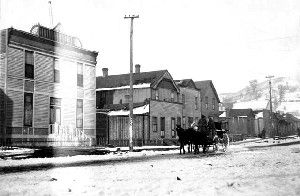
“The Row” Cripple Creek-1893. Courtesy Denver Public Library.
Purchasing a small frame house on Myers Avenue, she opened up for “business” and was an overnight success. Pearl, at 31, was described as red-haired, beautiful, strong-willed, and a shrewd businesswoman.
Though little is known of her background, historians believe that she was raised near Evansville, Indiana, by a good family. The family thought that Pearl worked as a dress designer for the wealthy wives of the area.
Catering to the more prosperous gentlemen of Cripple Creek, Pearl’s ladies were the most beautiful of any parlour in the camp, wore fine clothing, received monthly medical exams, and were paid well. And though the “good” women of Cripple Creek shuddered at the thought, Pearl pranced through the camp in a small open carriage, led by a team of fine black horses almost daily. Dressed in a different beautiful costume on every outing, her clothes were the envy of the women and produced the desired effect on the men, as they stared at her with longing.
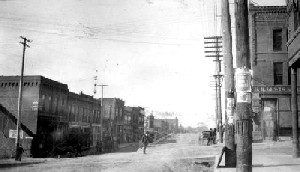
Bennett Avenue, Cripple Creek, Colorado.
Horrified at Pearl’s outings and the fact that Pearl’s ladies dared to shop on Bennett Avenue, the “good” women of the camp complained. Soon, Marshal Wilson regulated the shopping hours of “the girls,” allowing them to visit the stores only during “off hours.” In addition, each “working lady” was required to pay a six-dollar monthly tax, and madams were charged sixteen dollars a month. However, business was brisk, and this did little to diminish the popularity of the parlor houses. Meanwhile, Pearl continued her lively forays in her carriage through the streets of the camp. Children were forbidden to walk near Myers Avenue and were made to shield their eyes when Pearl paraded by in her fine carriage.
Soon, Pearl would meet a man named C.B. Flynn, the owner of a small mill. The two married in 1895; however, Pearl continued to run her profitable business. Not long after they were married, a fire raged through the camp, destroying Pearl’s business, Flynn’s mill, and most of the business district of the camp.
The fire ruined Flynn financially, and in order to get back on his feet, he accepted a job smelting iron and steel in Monterrey, Mexico. However, Pearl remained in Cripple Creek, intent on rebuilding her business. And rebuild, she did, with the finest parlour house that the city had ever seen. Opening in 1896, the two-story brick building was named “The Old Homestead.” Pearl spared no expense in decorating the opulent parlour, importing wallpaper from Paris, and outfitting it with the finest of hardwood furniture, expensive carpets, crystal electric chandeliers, and leather-topped gaming tables. The house even included a telephone, an intercom system, and two bathrooms, at a time when such things were mainly unheard of.
Four lovely girls joined Pearl in making her house the most whispered-about place in town. Drawing a wealthy clientele from as far away as Denver, the guests were required to provide references. At $250 a night, when $3 a day was considered a good wage for a miner, only the extremely wealthy could afford to visit The Old Homestead, and reservations were generally required.
Lavish parties were held at The Old Homestead, complete with tropical flowers and the finest food and drink. On June 4, 1897, Pearl threw a very extravagant party sponsored by a millionaire admirer from Poverty Gulch. Townspeople watched as cases of French champagne, Russian caviar, and Alabama Wild Turkey were carted into the parlor. Soon arrived two orchestras from Denver. This would be the party to “end all parties.” And, how foretelling that statement would become.
When Pearl appeared, she was resplendent in an $800 shell pink chiffon gown, complete with sequins and seed pearls, imported from Paris. During the evening, the madam had a bit too much to drink and excused herself, going upstairs to her bedroom. Pearl took some morphine to help her sleep, a common practice at the time.
During the night, one of her girls checked in on Pearl, who was lying in her bed, still draped in the chiffon ball gown. Finding her breathing heavily and unable to wake her, a doctor was immediately summoned. But it was too late, and at the age of 36, Pearl De Vere died on that early morning of June 5, 1897.
The coroner stated that Pearl died of an accidental morphine overdose to induce sleep. Most newspapers of the time reported this as a fact; however, at least one insinuated that Pearl had committed suicide. However, most historians dispute this, as Pearl was at her height of success and had no reason to take her life.
Pearl’s body was taken to Fairley Bros. and Lampman undertakers. When Pearl’s relatives were notified, her sister made the long train journey from Indiana. Having believed for years that Pearl was a dressmaker, she was shocked to find Pearl with dyed red hair and learned of her true vocation. Furious at the undertaker for letting her make the long journey, she left in a huff and refused any responsibility for her sister’s remains.
After Pearl was abandoned by her sister, it was revealed that she was not the wealthy madam everyone had assumed. In fact, her estate did not have enough money even to bury her properly. Pearl’s clientele proposed auctioning off the beautiful French gown. Still, before this could be done, a communication was received from Denver containing one thousand dollars and directing that she be buried wearing the lovely pink gown.
Pearl was interred with much pomp and circumstance. The funeral parade was led by the Elks Band, playing the Death March, and escorted by four mounted policemen. Carriages followed, filled with businessmen, girls from “The Row,” and many miners from the camp. Pearl’s lavender casket, covered with red and white roses, was lowered into her grave at the foot of Mt. Pisgah Cemetery and marked with a wooden marker.
Within just a few short years, Pearl and her grave were forgotten. It wasn’t until the 1930s, when Cripple Creek began to promote tourism with Cripple Creek Days, that people again became interested in the story of Pearl De Vere. Her grave had been lost in a weed-filled corner of the cemetery, with her name nearly eroded from the simple wooden marker.
Soon, a campaign to replace the wooden marker was begun, and the Wilhelm Monument Company donated a white marble heart-shaped stone that now rests atop her grave. The original wooden slab marker is now on display at the Cripple Creek District Museum.
The Old Homestead continued to operate until 1917. Later, it served as a boarding house and a private residence.
In 1957, the owners of the house discovered many original items and wanted to share the house with the public. After extensive renovations, The Old Homestead was opened as a museum in June 1958. Filled with many pieces of original furniture and displays that tell the story of the shady side of Cripple Creek, the house is the only original parlour to survive. Knowledgeable guides tell the story of the house, Pearl De Vere, and Cripple Creek in thirty-minute tours from Memorial Day through October.
Located on Myers Avenue, the store’s hours are 11 a.m. to 4 p.m. daily in summer and on winter weekends until Christmas.
More Information:
Old Homestead House Museum
353 Myers Avenue
Cripple Creek, Colorado 80813
©Kathy Alexander/Legends of America, updated August 2025.

While Cripple Creek, Colorado, is not a ghost town, it was one of the most important mining camps in Colorado. Photo by Kathy Wieser-Alexander.
Also See:
Painted Ladies of the Old West
Leading Madames of the Old West
Cripple Creek – World’s Greatest Gold Camp
Cripple Creek Gallery on Facebook
Ghosts of the Cripple Creek Mining District
See Sources.

